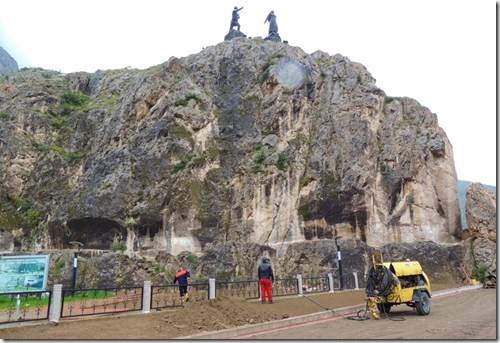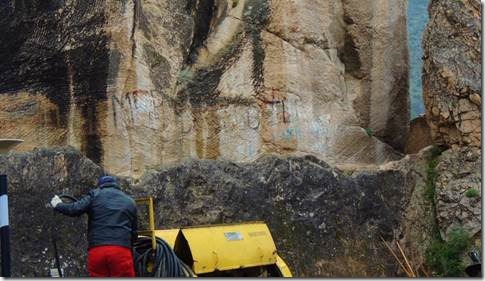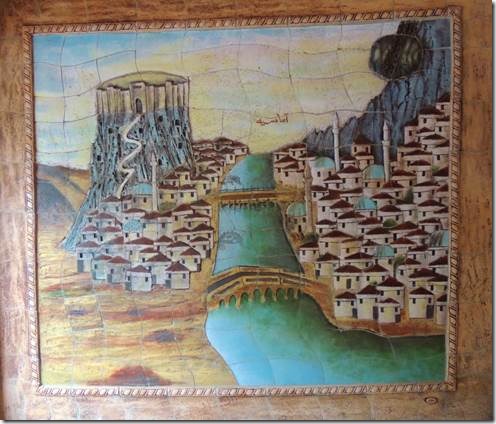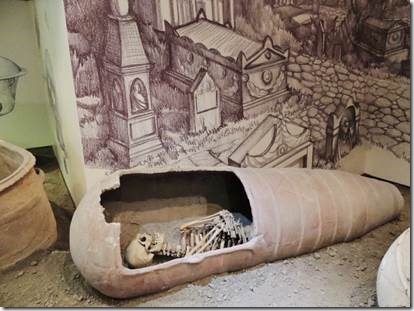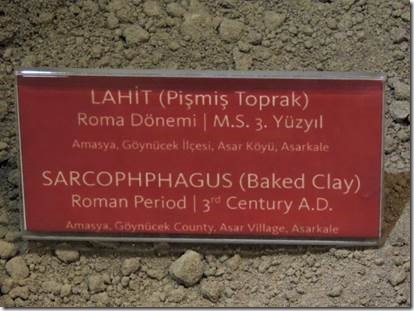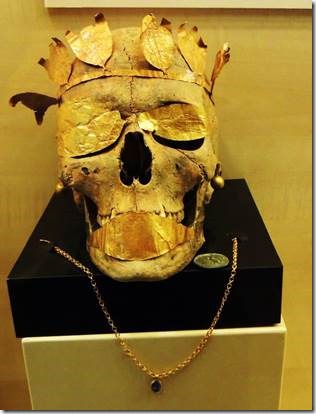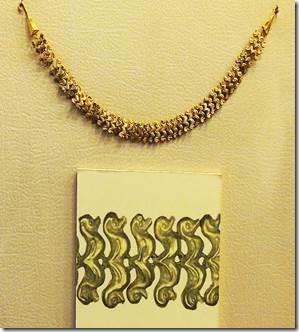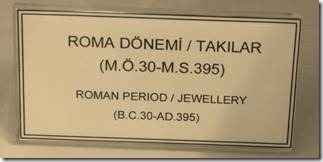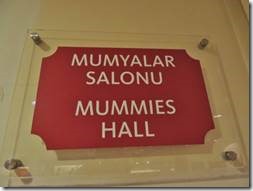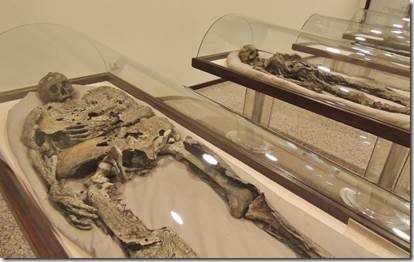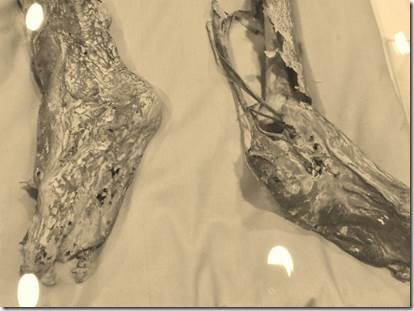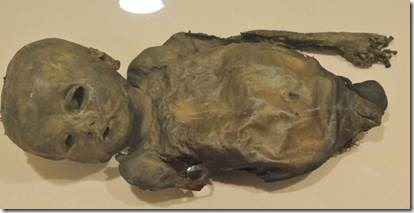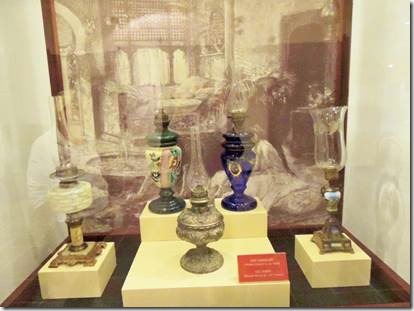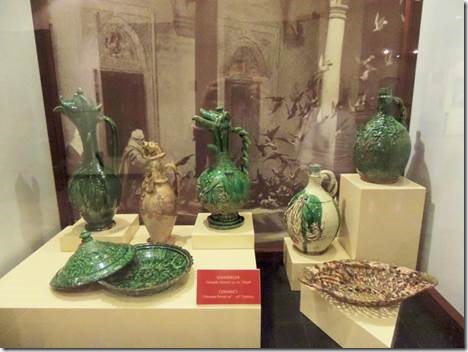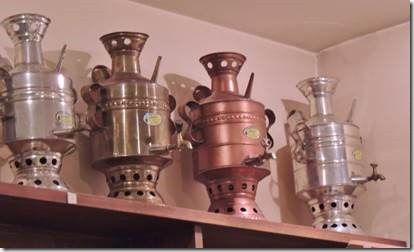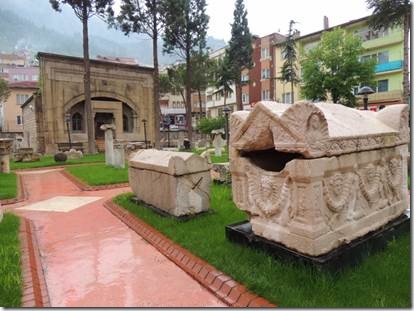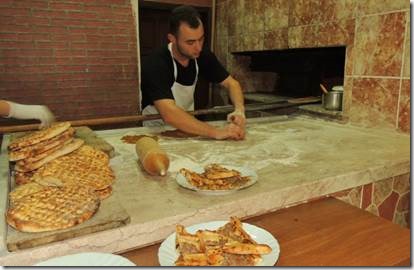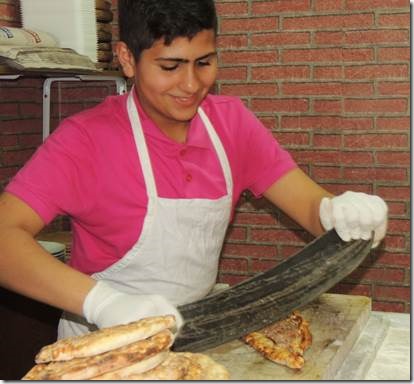Merhaba,
Today I had my first ride on a tractor! Patricia Clark, whom you met on the Amasya trip, and I went hiking in the hills. Just as we were taking off our shoes to ford an ankle-deep stream, we heard the sound of a motor. Patricia speaks Turkish so asked the tractor driver if we could have a lift across the stream. He courteously (and very Turkishly) agreed so we climbed aboard. He asked if we wanted a ride over the next two streams, but we said no thanks as we wanted to hike the distance between them. By the third stream we were starting to reconsider our decision, but the water was very cooling on this very hot day and the small stones had been smoothed over by the moving water. I took photos and that will be my next break from this Journey to Sinop segment of our Ankara trip.
Ru
This email maybe a bit upsetting with skeletons, “death jewelry” and mummies, one of which is a small child.
Our first stop, on the way to the museum was another visit with tragic lovers, Ferhat and Sirin.
|
Running parallel with the Amasya-Tokat road is the water course that inspired the legend of Ferhat and Shirin; the Ferhat Water Channel, nearly six kilometres long. But concerning the origins of this magnificent engineering, it is, of course, a matter of choice whether we believe the legend, or the archaeologists: who inform us it was built by the Romans. |
|
It’s hard to make it out but between the dark stone and light stone there is a channel. Journal of Applied Sciences Research, 5(12): 2109-2116, 2009 © 2009, INSInet Publication Corresponding Author: Yasemin KUSLU, Assistant Professor Dr. Atatürk University Faculty of Agriculture Department of Agricultural Structures and Irrigation 25240 Erzurum, TURKEY Phone: +90 442 231 3466 Fax: +90 442 236 0958 E-mail: ykuslu@atauni.edu.tr or ykuslu@hotmail.com 2109 Water Structures in Anatolia from Past to Present http://www.aensiweb.com/jasr/jasr/2009/2109-2116.pdf can probably answer any question you have about the Ferhat water channel or any in Anatolia We saw similar channels in Petra, Jordan. |
|
After stopping for photos at the Ferhat Water Channel we moved right along to the Amasya Museum. It would be a quickish visit as we had a long drive to Sinop and some stops to make. We also had to do a wine, corkscrew, and snacks run to the Migros across the road. Migros looks like Kroger or Shaws so no photos necessary. Amasya Museum…… A number of archaeological findings were collected in 1925 in two rooms inside the madrasa of Sultan Bayazid II Kulliye, which, together with the mummies from the Ilkhanate, were initially placed in a “museum warehouse”. As the number of items to be displayed grew, it became evident that new locations were needed. Thus, all the items were moved in 1962 to the Gökmedrese Mosque, a building that dates back to the Seljuk Era. The museum moved to its current modern building on 22 March 1977. Following a detailed work for rearrangement, all items were classified according to a chronology-based listing and the museum officially opened in 1980. The Archaeological Museum of Amasya consists of three sections: the Hall of Archaeological Artifacts, where items from 13 civilizations are on display; the Hall of Ethnographical Artifacts, where items from regional handicrafts and life culture are on display; and the Hall of Mummies inside the Sultan Mesud I Tomb in the museum yard, where mummies from the Ilkhanate period are displayed. Amasya Museum consists of Şehzadeler Museum, Milli Mücadele Museum, and Hazeranlar Konağı Museum http://www.yesilirmakbasinmuseums.org.tr/amasya/mn1.html http://www.yesilirmakbasinmuseums.org.tr/amasya/mn1.html is a virtual tour of the museum. |
|
Painting in the lobby of the Amasya museum. I wish I could do this, capture the idea of a place and leave off everything else. I’m still trying to do that with Marmaris harbor, but so far no luck. |
|
Embalmed rulers a draw in Amasya HDN | 8/12/2009 12:00:00 AM | AMASYA – İhlas News Agency http://www.hurriyetdailynews.com/default.aspx?pageid=438&n=mummy-returns—2009-08-12 Mummification, a practice usually associated with the culture of ancient Egypt, was also known and used in the territories that today comprise modern Turkey. The concept of mummification, a practice usually associated with the culture of ancient Egypt, was also known and used in the territories that today comprise modern Turkey. A local museum in the 7,500-year-old central Anatolian city of Amasya contains one of the world’s most impressive mummy collections, one that could easily compete with better-known groupings. Among the first bodies mummified in that area was Amasya Governor Sehzade Cumudar, along with members of his family, including his wife and children. They are believed to have been poisoned or garroted by Mongol invaders, who attacked in the 14th century. Two other Amasya rulers, İşbuğa Noyina and Pervane, were also mummified after their deaths, however, in these cases a method different from the Egyptian one was used. The mummified bodies still contain internal organs, in contrast to the Egyptian method, in which the entrails are removed. The 17th century Turkish traveler and writer Evliya Celebi mentioned the Amasya mummies in his journals. The mummies were kept in the depot of the old Amasya Museum after it was established in 1925. Before they had a chance to be exhibited, however, the mummies were partially damaged by flooding in the city center. In 1962, the mummies were transferred to another location, the Gokmedrese Mosque, which was turned into a museum. Later, they were moved again, this time for exhibition in the tomb of Sultan Mesut, located in the garden of the contemporary Amasya Museum, right after the institution was established in 1976. Amasya Museum researcher Muzaffer Doğanbaş considers mummification, also known in Turkish as “tahnit,” as a kind of art. “Turks have their own special mummification tradition that is different from the Egyptian or Russian methods,” Doğanbaş said. “However, today we do not have mummification experts in Turkey.” According to the researcher, there are nearly 40 different chemicals and medicines used for mummification in Turkey. “[The methods] were mentioned in Hacı Paşa’s book ‘Şifa-ül Eksan,’ written in 1380,” Doğanbaş said, “For example, the salt we use for cooking is a material used in mummification, as is the onion.” Doğanbaş said that tahnit experts were also educated in the medical sciences. “The Ottoman Empire had assigned officers who attended the mummification of sultans and princes,” he said. “Excepting Osman Gazi, Orhan Gazi, Yavuz Sultan Selim and Bayezid II, almost all of the Ottoman sultans were mummified.” Currently, there are seven museums in Turkey with mummies in their collections, along with known mummy samples in some of the country’s Ottoman and Seljuk tombs. |
|
The mummies of the children are just so sad, and I hesitated to include this but it was mentioned in the Hurriyet article above and the one below mentions that Nat Geo Researchers could still identify diseases in the children caused by their diet. http://www.trt.net.tr/trtworld/en/newsdetail.aspx?haberkodu=1d7001ac-dcf9-4009-91a6-cfa547f59e51 is another story: “The National Geographic researchers came to Amasya for the mummies in 2002 and conducted some endoscopic examination on the mummies and saw that the internal organs were still in the mummies, Özdemir points out , adding that even the diseases the children in particular suffered from because of the things they had eaten were diagnosed.” |
|
On a “lighter” note, lovely Turkish oil lamps. |
|
Ceramics |
|
And more examples of Turkish copper samovars. |
|
Museum Garden Sarcophagus Material: Limestone Dimensions: l:2.15cm w:85cm h:60cm Period: Roman Place: Merzifon “In the museum yard, big stone pieces from the Hittite, Hellenistic, Roman, Byzantine, Ilkhanate and Ottoman periods are displayed in open air.” |
|
From that rather gruesome stop we went on to lunch: by the lake at the foot of the mountain with the castle somewhere between Amasya and Sinop. |
|
Though pide was a specialty of the house, I was full of Migros snacks so just had some soup and a bit of the wonderful round bread. |

